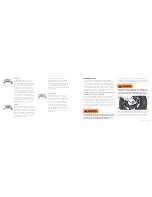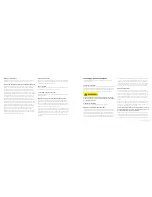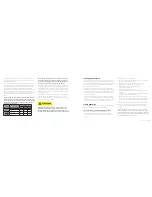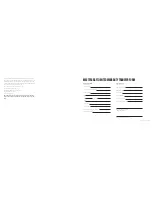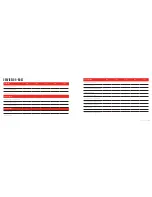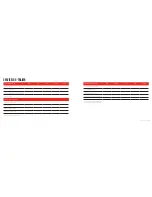
2017 OWNERS MANUAL /
432
be careful to avoid soft shoulders. Running on soft shoulders could
cause the trailer to jack-knife or go out of control.
Avoid sudden steering maneuvers
These may create sway or undue side force on the trailer. To control
swaying caused by air pressure changes and wind buffeting when
larger vehicles pass from either direction, release the accelerator
pedal to slow down. Keep a firm grip on the steering wheel.
Allow considerably more distance for stopping
There is considerably more weight to be maneuvered, and even
though your trailer is equipped with a braking system, it is highly
likely that additional room will be needed in order to execute slowing
or full stops.
Check the rear view mirrors
If not already equipped with them, install outside rear view mirrors
on both sides of the tow vehicle. Make it a habit to check the mirrors
at frequent intervals to be sure the trailer and boat are riding prop-
erly.
Swing wider
Trailer wheels are closer to the inside of turns than the wheels on
the tow vehicle. This means swinging wider at curves and corners,
will be required to prevent impacts between the trailer and other
objects.
4. Check under the coupling to be certain that the ball clamp is
below the ball and not riding on top of the ball.
5. Lock the coupler to the hitch ball. To confirm that the coupler is
locked onto the hitch ball, lift up on the trailer using the jack. If
the trailer coupler comes loose from the hitch ball, unlock and go
back to the third step above.
6. After the coupler is properly locked on to the hitch ball, be certain
that the trailer jack is in the fully raised and locked position.
7. Attach the surge break-away cable to the tow vehicle, making
sure there is enough slack for tight turns.
8. Attach the safety cables.
9. Connect the trailer’s seven-wire connector to the seven-wire
connector of the tow vehicle and check the operation of the trailer
lights (break lights, turn signals, running lights).
Trailer Tips And Techniques
With a boat trailer in tow, an operator will be driving down the road
with a vehicle combination that is longer, heavier and sometimes
wider and taller than the tow vehicle. This means the operator
should make a few adjustments to normal driving practices to com-
pensate for the differences.
Use common sense
MasterCraft cannot anticipate every type of situation in which driv-
ers may find themselves. The following recommendations apply to
general situations, but it is up to the individual driver to properly and
Do not control trailer sway by using vehicle brakes
Especially avoid jamming on the brakes hard. Generally, this type of
action makes the sway worsen.
Pay attention to wind
Be prepared for sudden changes in air pressure and/or wind buf-
feting when larger vehicles pass from either direction. Slow down a
little and keep a firm hand on the steering wheel.
Do not tow with folding tower in the DOWN position
Towing the boat with the tower in the UP position prevents prema-
ture wear. If the boat is equipped with a Bimini top, the top should
be closed. If the tower has board racks, be sure that the board racks
are folded to the inside.
Conserve fuel
Wind resistance against the boat and trailer can reduce gas mile-
age significantly, especially at higher speeds.
Avoid sudden stops and starts
Even though the trailer has brakes, a sudden stop can cause it to
skid, slide or even jack-knife. (Be especially careful to avoid the
necessity for quick stops while turning.) Smooth, gradual starts and
stops will improve gas mileage and put less strain on the tie-downs,
etc.
safely act or react as a given situation requires.
Take a shakedown cruise.
Before making the first major trip or lake cruise with a MasterCraft
trailer, make at least one short trial run to become familiar with its
handling characteristics. Be sure everything is working properly
Slow down
There is less strain on the tow vehicle, trailer and boat at moderate
to slow speeds. Also, many states have lower speed limits for vehi-
cles towing trailers. Driving at moderate speeds will place less strain
on the tow vehicle and the trailer. Trailer instability (sway) is more
likely to occur as speed increases. Particular attention needs to be
given to all aspects of towing when traveling over bumpy roads and
railroad crossings.
Allow extra time and space
You’ll need more of both when passing and stopping.
Pass with extra care
Signal well in advance and make sure you allow extra distance
to clear the vehicle you are passing before you pull back into the
lane. Pass on level terrain with plenty of clearance. Avoid passing
on steep up or down grades. Down shift as necessary to improve
acceleration or speed maintenance. When passing on narrow roads,
Summary of Contents for NXT20 2017
Page 3: ...2017 OWNERS MANUAL SAFETY KNOWLEDGE ...
Page 27: ...2017 OWNERS MANUAL 48 2017MODEL FEATURESANDSPECS ...
Page 40: ...2017 OWNERS MANUAL 74 DASHESAND VIDEOSCREENS ...
Page 42: ...2017 OWNERS MANUAL 78 XANDXTSERIESINSTRUMENTPANEL 4 3 VIDEOSCREEN XSTARINSTRUMENTPANEL ...
Page 43: ...2017 OWNERS MANUAL 80 PROSTARINSTRUMENTPANEL NXTSERIESINSTRUMENTPANEL ...
Page 58: ...2017 OWNERS MANUAL 110 XANDXTSERIES VIDEOSCREEN OPERATIONSHV450 ...
Page 67: ...2017 OWNERS MANUAL 128 XSTAR VIDEOSCREEN OPERATIONS XSTARINSTRUMENTPANEL ...
Page 80: ...2017 OWNERS MANUAL 154 PROSTAR VIDEOSCREEN OPERATIONS ...
Page 97: ...2017 OWNERS MANUAL 188 NXT OPERATIONS ...
Page 101: ...2017 OWNERS MANUAL 196 NXT20 22 VIDEOSCREEN OPERATIONS ...
Page 107: ...2017 OWNERS MANUAL 208 BOAT OPERATIONS ...
Page 158: ...2017 OWNERS MANUAL 310 PREPARATION ...
Page 172: ...2017 OWNERS MANUAL 338 CAREAND MAINTENANCE ...
Page 204: ...2017 OWNERS MANUAL 402 TRAILERS ...











